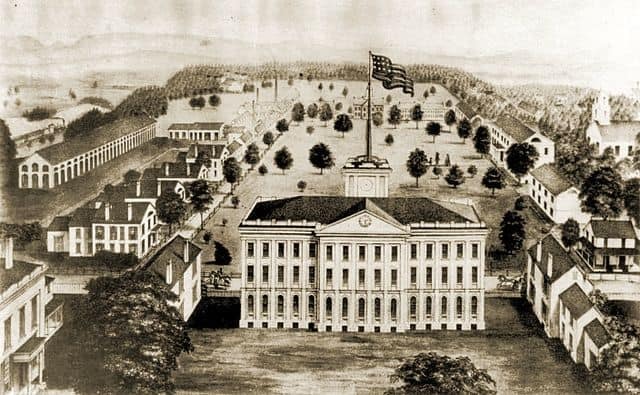
Springfield Armory: The Heartbeat of American Military Innovation
The Springfield Armory, established in 1794 under the administration of President George Washington and the direction of Secretary of War Henry Knox, remains one of the most storied institutions in American history. As the United States’ first federal armory, it played an instrumental role in arming the military, pioneering industrial manufacturing techniques, and setting the stage for centuries of firearms innovation. From the early flintlock muskets of the 18th century to the battle-proven M1 Garand of World War II, the Springfield Armory was at the forefront of American military excellence until its closure in 1968. Today, its legacy continues through historical preservation and the influence it left on modern firearms manufacturing.
Founding and Strategic Importance
Following the American Revolution, the fledgling United States recognized the critical need for a reliable and self-sufficient arms manufacturing facility. The nation had depended heavily on imported and privately crafted weapons during the war, creating logistical and quality-control issues. Based on recommendations from Henry Knox, George Washington’s War Department selected Springfield, Massachusetts, as the site for the first national armory.
Several factors influenced this decision. Springfield’s inland location made it less vulnerable to naval attack, a significant concern given the British naval superiority at the time. The area was also rich in resources, with proximity to the Connecticut River facilitating transportation and water-powered machinery. The growing community in Springfield provided a workforce skilled in metalworking and mechanical engineering, setting the stage for rapid technological advancements.
Early Firearms Production and Interchangeable Parts
Springfield Armory’s first major contribution to American arms manufacturing was the Model 1795 Musket, a direct derivative of the French Charleville Model 1777 Musket, which had been widely used by American forces during the Revolution. The Model 1795 was the first standardized firearm produced in the United States and was manufactured concurrently at Harpers Ferry Armory, which was established in 1799.
One of the most revolutionary innovations associated with Springfield was the development and implementation of interchangeable parts. While early proponents like Eli Whitney gained fame for promoting the concept, it was actually perfected and widely implemented at Springfield through the work of Thomas Blanchard in the early 19th century. Blanchard’s invention of specialized lathes and milling machines allowed for mass production of firearm components that could be easily swapped and replaced—a critical advancement in both military logistics and industrial manufacturing.
Firearm Innovations and Key Contributions
Throughout the 19th and 20th centuries, Springfield Armory remained at the cutting edge of firearms technology. Some of its most significant contributions include:
Springfield Model 1855 and Model 1861 Rifles
As tensions escalated toward the Civil War, Springfield Armory produced some of the most important weapons of the era. The Springfield Model 1855 Rifle-Musket introduced the Maynard tape primer system, a rudimentary attempt at improving ignition reliability. However, the Springfield Model 1861, a refined percussion-cap musket, became the standard rifle of Union forces and was produced in greater numbers than any other firearm during the war.
The Model 1861, with its rifled barrel, dramatically improved range and accuracy over earlier smoothbore muskets, giving Union troops a significant battlefield advantage. By the war’s end, Springfield Armory had solidified its reputation as the premier arms manufacturer in the United States.
Springfield Model 1903: A New Standard
The Springfield Model 1903 rifle was developed in response to the superior performance of the German Mauser 98 during the Spanish-American War. The U.S. military recognized that its existing Krag-Jørgensen rifles were obsolete and needed an upgrade.
The Model 1903 borrowed heavily from the Mauser action, incorporating a strong bolt-locking system and a five-round internal magazine. This design was so closely based on the Mauser system that the U.S. government was forced to pay royalties to Mauser Werke for patent infringement.
The Model 1903 became the standard U.S. infantry rifle until the introduction of the M1 Garand and saw extensive use in World War I, continuing in specialized roles through World War II and beyond.
M1 Garand: The Rifle That Won World War II
Perhaps the most famous firearm developed at Springfield Armory was the M1 Garand, a semi-automatic battle rifle designed by John C. Garand in the 1930s. Officially adopted in 1936, the M1 Garand became the standard-issue rifle for American forces during World War II.
General George S. Patton famously called the M1 Garand “the greatest battle implement ever devised.” Unlike its bolt-action counterparts used by most other nations, the M1 Garand allowed U.S. troops to fire faster, reload quickly with en-bloc clips, and maintain a superior rate of fire in combat.
During World War II alone, Springfield Armory produced over 3.5 million M1 Garands, cementing its place as the backbone of American firepower.
The Transition to the M14 and the Armory’s Closure
In the 1950s, Springfield Armory developed the M14 rifle, an evolution of the M1 Garand incorporating a detachable box magazine and selective-fire capability. While initially promising, the M14 proved too heavy and cumbersome for Vietnam-era jungle warfare, leading to its rapid replacement by the M16 rifle in the 1960s.
By 1968, the U.S. Department of Defense shifted toward contracting arms production to private companies like Colt and FN Herstal, leading to the closure of Springfield Armory. This decision was controversial, as it marked the end of nearly two centuries of government-run small arms production.
The Armory’s Legacy and National Historic Site
Although the original facility ceased arms production, its historical significance was recognized in 1974 when it was designated the Springfield Armory National Historic Site under the National Park Service. The site now serves as a museum preserving the legacy of the armory, housing one of the most comprehensive collections of historic U.S. military firearms.
The museum’s exhibits showcase original M1 Garands, Springfield Model 1903s, Civil War muskets, and other iconic weapons that defined American military history. Educational programs and historical reenactments continue to keep the armory’s story alive for new generations.
Springfield Armory, Inc.: The Commercial Legacy
It is important to note that the modern Springfield Armory, Inc., founded in 1974, is a private company that bears the name but has no direct lineage to the historic U.S. government armory. The company produces semi-automatic versions of the M1A (a civilian version of the M14), 1911 pistols, and other modern firearms inspired by classic designs. Despite the lack of direct continuity, Springfield Armory, Inc. has built a strong reputation in the firearms industry, carrying forward the legacy of American innovation.
Conclusion
The Springfield Armory was more than just a weapons factory; it was a crucible of American ingenuity, industrial progress, and military dominance. From the first standardized muskets of the post-Revolutionary period to the semi-automatic rifles that defined 20th-century warfare, Springfield’s impact on U.S. military history is undeniable.
Though the original armory closed in 1968, its technological innovations, historical significance, and contributions to American military success ensure that the name Springfield Armory will forever be synonymous with excellence. Today, through historical preservation efforts and its influence on modern firearms manufacturing, its legacy continues to stand as a testament to American resilience and engineering prowess.
Read more here:
Visit the National Park Service's Springfield Armory National Historic Site. Click here for details.
If you know of any forums or sites that should be referenced on this listing, please let us know here.







